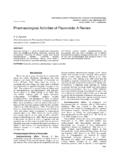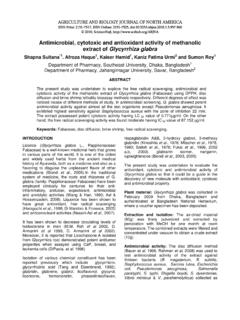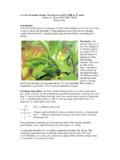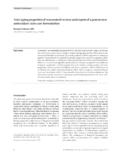Transcription of Schiff Base: An Overview of its Medicinal Chemistry ...
1 Review Article Schiff base : An Overview of its Medicinal Chemistry Potential for New Drug Molecules R. Sahu*, Thakur and P. Kashyap Shri Rawatpura Sarkar Institute of Pharmacy, Kumhari-490042, India. Received April 27, 2012; accepted July 26, 2012 ABSTRACT Schiff base denotes a reaction product of a primary amine and a carbonyl compound. Schiff bases possess a wide variety of biological activity specially antibacterial and antifungal properties. Metal complexes of Schiff base have been studied for their biological activities. This review articles provide a summary of Medicinal Chemistry features of Schiff base and various reports published on biological activities of Schiff base and its metal complexes.
2 KEYWORDS: Schiff base ; antibacterial activity; antifungal activity; anticancer activity; anti HIV activity; antioxidant activity. Introduction A Schiff base (or azomethine) is a functional group that contains a carbon-nitrogen double bond with the nitrogen atom connected to an aryl or alkyl group, but not hydrogen. Schiff bases are of the general formula R1R2C=N-R3, where R3 is an aryl or alkyl group that makes the Schiff base a stable imine. A Schiff base derived from an aniline, where R3 is a phenyl or substituted phenyl, can be called an anil. Schiff bases are a very interesting group of compounds for studying hydrogen bond properties.
3 The important physical and biological properties of Schiff bases are directly related to the presence of the intramolecular hydrogen bond and a proton transfer equilibrium. This group of compounds is characterized by great biological activity and they play an important role in biological systems. For instance in rodopsine, halorodopsine and bacteriorhodopsine the retinal molecule is connected to peptide through NH2 group of lysine residue forming a Schiff base . Furthermore, Schiff bases are observed in various enzymes such as tryptophan synthase, transaminases, transketolases etc.
4 The hydrogen bond properties of mono and di Schiff bases, derivatives of salicylic aldehyde and 2,6- diformylphenol, have been intensively studied using NMR, FT-IR, UV and crystallographic methods because of their practical importance. In Schiff bases, derivatives of salicylic aldehydes, the OH N intramolecular hydrogen bond is non-linear. In most Schiff bases the proton is localized at the oxygen atom and in some cases it fluctuates within the OH N hydrogen bond or is localized at the nitrogen atom. Proton transfer can occur both in solid and solution, in the basic and excited states.
5 Structure CHR'"R''NCR'R Synthesis A Schiff base is a nitrogen analogue of an aldehyde or ketone in which the carbonyl group is replaced by a C=N-R group. Schiff bases can be synthesized from an aromatic amine and a carbonyl compound by nucleophilic addition forming a hemiaminal, followed by a dehydration to generate an imine. It is usually formed by condensation of aldehyde or ketone with a primary amine. CHNH2 COR''R'''RR'CHR''R'''NCRR'OHHHCHR'"R''NC R'RHOH International Journal of Pharmaceutical Sciences and NanotechnologyVolume 5 Issue 3 October December 2012MS ID: IJPSN-4-27-12-SAHU1757 1758 Int J Pharm Sci Nanotech Vol 5; Issue 3 October December 2012 Biological Activity A number of 3-aryl-[(1-isocyano-4-methyl-7-hydroxy coumarin)]-5-methyl-1,3,4-triazoline-2-o nes were synthe-sized by condensation of 1,2,4-triazole-3-ones with 8-formyl-7-hydroxy-4-methyl coumarin and evaluated for antimicrobial activity by cup-plate method using norfl-oxacin and griseofulvin as standard.
6 All the compounds showed antimicrobial activity (Kumar et al., 2010). NNNOCH3 NCHOOCH3 HOR1R2 Esters of Schiff base were synthesized by refluxing ferrocenyl aniline and simple aniline with long chain esters formed by reacting different long chain alkyl aliphatic acids with corresponding aldehydes. Synthesized organic and ferrocene containing Schiff bases were evaluated for antitumor, antioxidant and DNA protecting activity. All the compounds were evolved as potent antitumor, antioxidant and DNA protecting activity. Ferrocene containing Schiff base showed more activity than organic Schiff base (Haq et al.)
7 , 2009). COOR2R1 CHNYY=, Ferrocene The Schiff base of chitosen, a biocompatible non-toxic polymer, was synthesized by reaction of chitosen with citral, was evaluated for antibacterial and antifungal activity using strains of E. coli, S. aureus and A. niger. Synthesized compounds evolved as potent antimicrobial agent (Jin et al., 2009). OHHHNHOHCH2 OHHOCHHCCHH2 CCH2CH2 CHCCH3CH3 A series of quinolin-2(1H)-one-triazole derived Schiff base ligands were synthesized by condensation of 4-amino-1,2,4-triazole with N-substituted-3-formyl-4-hydroquinolin-2 -(1H)-one. The compounds on investi-gation of antimicrobial activity were found to be active against fungal strain but inactive against Gram-positive and Gram-negative bacteria (Creaven et al.
8 , 2010). NOHONHNNNR New tridentate Schiff base were prepared by condensing S-2-picolyldithiocarbazate with pyridine-2-carboxaldehyde, 2-acetylpyrrole and 2-acetylthiophene while a bidentate Schiff base was prepared by conden-sing the S-2-picolyldithiocarbazate with 2-acetylfuran. Synthesized Schiff base were evaluated for cytotoxic and antimicrobial activities. Bidentate Schiff base and the Schiff base prepared from 2-acetylthiophene showed activity against a number of bacteria while Schiff base prepared from pyridine-2-carboxaldehyde were evolved as a cytotoxic agent against human cell T-lymphoblastic leukemia and human colon adrenocarcinoma cell.
9 Further, all the Schiff base were complexed with Ni (II). None of the complexes showed activity against Human cell T-lymphoblastic leukemia (Crouse et al., 2004). CNNCSHSH2 CNH3 CNH A variety of Schiff base containing thiazolyl, benzothiazolyl and vanillin moieties were evaluated for their effect on nitric oxide production, PGE2 production and release of glucosaminoglycans on pig cartilage cultures treated with interlukin 1 to establish anti-degenerative activity. These compounds decreased the in vitro degradation of pig cartilage in presence of interlukin 1 (Cardile et al.)
10 , 2002). NSNH3C(H2C)13 CHOHSNNCHR1R2OH Sahu et al: Schiff base : An Overview of its Medicinal Chemistry Potential for New Drug Molecules 1759 A moderate antibacterial activity was shown by some new tetradentate Schiff base while their Cu(III) and Fe(III) complexes showed both antibacterial and antifungal activity employing tetracycline and amphotericin B as standard (Abdallah et al., 2010). HCNCHNCOOHCOOH A series of novel Schiffs base derivatives with different substituent were screened for antibacterial activity against S. areus. Synthesized compounds showed a significant antibacterial activity (Xia et al.







